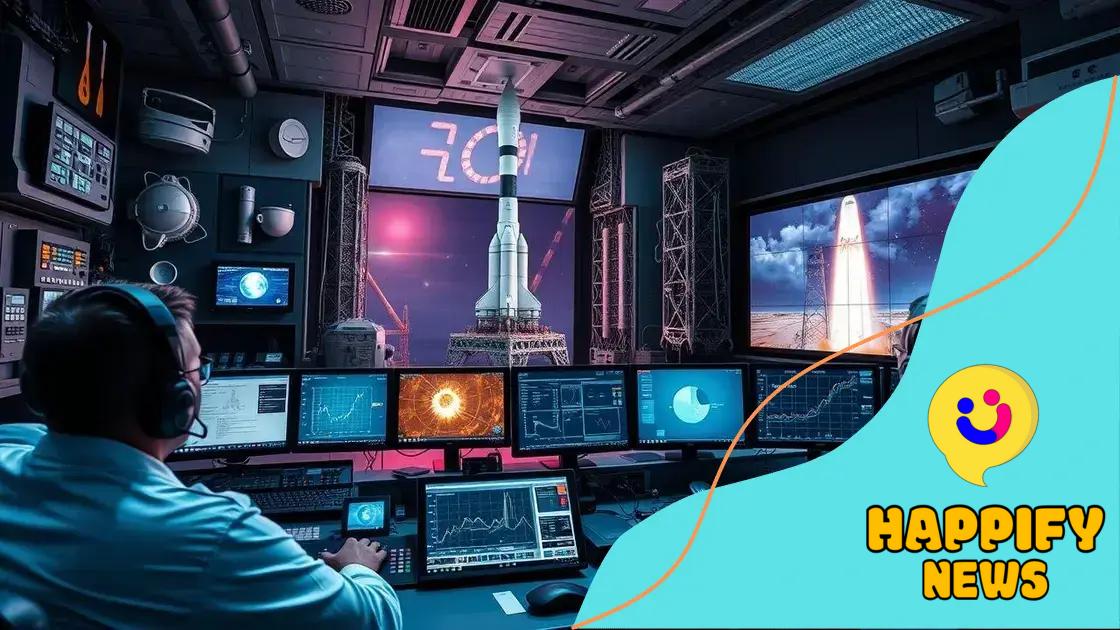Space tourism and private companies: the future of travel

Anúncios
Space tourism is an emerging industry led by private companies like SpaceX and Virgin Galactic, making space travel more accessible through technological advancements and increasing interest in recreational space exploration.
Space tourism and private companies are on the brink of transforming how we experience travel. Have you ever dreamed of seeing Earth from above? Today, that dream is becoming a reality for many. Let’s dive into what’s happening in this fascinating industry.
Anúncios
Overview of space tourism
Space tourism is an exciting new industry that combines adventure with the final frontier. The idea of visiting space isn’t just a dream anymore—it’s becoming a reality for many. More and more people are eager to experience the thrill of floating in a spacecraft and seeing Earth from above.
What is Space Tourism?
Space tourism refers to the practice of traveling into outer space for recreational, leisure, or adventure purposes. Unlike traditional tourism, which typically involves travel to earthly destinations, space tourism takes individuals beyond the atmosphere. Companies are working to make space accessible, giving people the chance to take part in this extraordinary experience.
Key Features of Space Tourism
Several aspects distinguish space tourism from regular travel:
Anúncios
- Zero Gravity Experience: Passengers will float in a state of weightlessness, making for a thrilling adventure.
- View of Earth: Travelers can witness breathtaking views of our planet from space, creating unforgettable memories.
- Short Duration: Most space trips last a few days, allowing tourists to enjoy the journey without a long commitment.
For many, the biggest attraction of space tourism is the opportunity to be part of an exclusive group exploring the unknown. Companies like SpaceX, Blue Origin, and Virgin Galactic are leading the charge in this burgeoning industry, aiming to offer trips that can be affordable in the future.
As technology rapidly evolves, the possibilities for space travel continue to expand. Innovations in spacecraft design and safety measures make it more feasible for a wider range of individuals to consider making the trip. This expansion of space tourism also raises questions about the impact it will have on our planet. Concerns around sustainability and environmental impact are central to discussions on how to responsibly develop this industry.
In conclusion, space tourism is an expanding frontier that promises thrilling experiences for those daring enough to embark on the journey. The developments in this field are paving the way for a new form of exploration that can redefine how we view travel.
Key players in the private sector
In the rapidly growing field of space tourism, several private companies are leading the charge. These key players are pioneering innovative technology and making space travel more accessible. Their efforts are changing how we view our universe and what is possible for the future of travel.
Leading Companies
Some of the most notable companies in the private space sector include:
- SpaceX: Founded by Elon Musk, SpaceX has revolutionized space transportation. Their Falcon 9 rocket has made history with successful launches and landings, paving the way for human travel to space.
- Blue Origin: Founded by Jeff Bezos, Blue Origin aims to enable millions of people to live and work in space. Their New Shepard rocket is designed for suborbital flights, offering tourists a short taste of space.
- Virgin Galactic: Established by Richard Branson, Virgin Galactic focuses on commercial spaceflight and aims to take paying customers to suborbital space. Their SpaceShipTwo is built for an exhilarating ride.
These companies not only compete but also collaborate, fostering innovation within the industry. One of the main goals for these firms is to reduce the cost of space travel, making it accessible to more people.
With advancements in technology, companies are constantly enhancing safety and reliability. As revenue from space tourism increases, more players are likely to join the sector. This could lead to a more dynamic market where competition spurs further innovation.
Additionally, these key players are actively involved in discussions about the future of space travel, including the ethical implications of space tourism. As space travel becomes a reality for an increasing number of people, it is essential to consider the environmental impact and sustainability of future missions.
Technological advancements in space travel

Technological advancements in space travel are leading to new possibilities for exploration and tourism. Innovations in technology are making it feasible for ordinary people to journey into space. From the design of spacecraft to advancements in propulsion systems, each development pushes the boundaries of what we thought was achievable.
Key Innovations
Recent technological breakthroughs include:
- Reusable Rockets: Companies like SpaceX have pioneered reusable rocket technology, significantly reducing launch costs and increasing sustainability.
- Advanced Life Support Systems: These systems are essential for long-duration flights, providing astronauts and tourists with clean air, water, and food.
- New Propulsion Methods: Innovations like ion propulsion and hybrid engines are enabling faster and more efficient travel within and beyond Earth’s orbit.
The design of spacecraft has also evolved significantly. For example, capsules are now designed with safety as a priority, featuring advanced parachute systems and escape mechanisms. As space tourism gains momentum, it is crucial that safety remains at the forefront of these advancements.
Moreover, simulation and training technologies have improved, allowing future astronauts and tourists to prepare for their journey. Virtual reality is now used to simulate the experience of space travel, helping customers learn what to expect during their trip.
The collaboration between private companies and governmental space agencies is also fostering new technologies. By sharing resources and expertise, these partnerships are accelerating the development of new systems for space travel. Every innovation brings us one step closer to a future where space tourism becomes a regular part of life for many people.
Challenges faced by private companies
Private companies in the space tourism industry face many challenges that could impact their growth and success. As this industry evolves, these challenges become more apparent, and addressing them is essential for the future of space travel.
Regulatory Hurdles
Navigating regulations is one of the biggest challenges for these companies. Space is governed by international and national laws that control who can launch and operate missions. Companies must obtain various licenses and approvals, which can be a lengthy and complex process, delaying their projects.
Safety Concerns
Ensuring the safety of passengers and crew is paramount. Space travel carries inherent risks, and any accidents can lead to loss of life and damage to a company’s reputation. Companies invest heavily in technology and protocols to mitigate these risks, but the stakes remain high.
- Testing and Validation: Extensive testing is required for every system to ensure reliability.
- Emergency Protocols: Developing effective plans to handle potential emergencies is essential.
- Insurance: High insurance costs associated with space travel can strain financial resources.
Moreover, with the increasing competition, companies must constantly enhance their safety measures, which can be financially challenging.
Another significant challenge is the high cost of development and operation. Building spacecraft requires advanced technology, skilled personnel, and substantial capital investment. Many startups struggle to secure the funds needed to bring their ideas to life. Public interest in space tourism is growing, yet consistent revenue generation can be elusive.
In addition to funding issues, companies must also address market demand. Space tourism is still in its infancy, and it remains to be seen how many people will be willing to invest in this experience. The questions of affordability and accessibility still linger. As companies strive to lower costs, they must balance profit with making space travel available to a wider audience.
Future trends in space tourism
The future of space tourism is bright and filled with exciting potential. As technology progresses and interest in space travel grows, various trends are emerging that could reshape the industry.
Increased Accessibility
One of the most significant trends is the push towards making space travel more accessible. As companies innovate and competition increases, the costs of flights will likely decrease. This will allow more people to experience space tourism, not just the wealthy.
Suborbital and Orbital Flights
Both suborbital and orbital flights are gaining traction. Suborbital flights provide a short experience of weightlessness and stunning views of Earth, while orbital flights offer a more extended experience. Companies are exploring ways to offer both types of trips, catering to different preferences and budgets.
- Luxury Space Hotels: Future space tourism may include luxury hotels in orbit, providing travelers with unique accommodations and stunning views.
- Spaceports and Infrastructure: The construction of spaceports around the globe will be vital for accommodating increased traffic. More spaceports mean more opportunities for launches.
- Involvement of Governments: As private companies continue to progress, government agencies may partner with them to foster growth in this industry.
Moreover, the integration of virtual and augmented reality into training will enhance the space tourism experience. As potential astronauts train for their flights, these technologies will help them prepare for the realities of space travel.
Additionally, as public interest grows, we might see more educational programs focused on space. Schools may incorporate space tourism into their curriculums, inspiring the next generation of space enthusiasts.
Ultimately, the future of space tourism is poised to expand rapidly, driven by technology and human curiosity. As we look ahead, the possibilities are limitless, and the dream of traveling to space may soon be a reality for many.
\n
FAQ – Frequently Asked Questions about Space Tourism
What is space tourism?
Space tourism is the practice of traveling into outer space for recreational purposes, allowing individuals to experience space travel.
Who are the main companies involved in space tourism?
Key players in space tourism include SpaceX, Blue Origin, and Virgin Galactic, each contributing unique innovations to the industry.
What are some risks associated with space tourism?
Risks include safety concerns during travel, regulatory challenges, and the high costs of development and operation for space missions.
How can space travel become more affordable in the future?
As technology advances and competition increases, costs are expected to lower, making space travel accessible to a broader audience.






